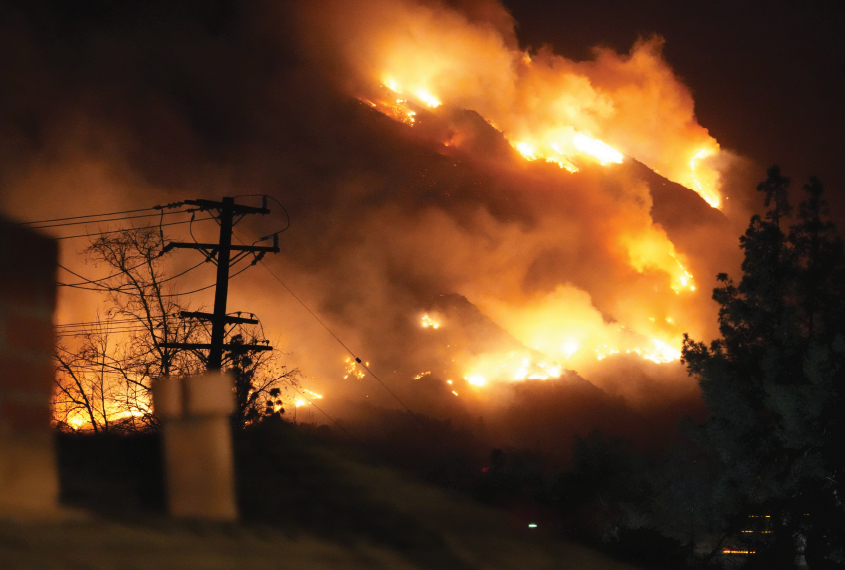Although 2023 made headlines as the hottest year in human history,1 drawing the world closer to breaching the goals outlined in the Paris Agreement to substantially reduce global greenhouse gas emissions to limit global warming to well below 2°C above preindustrial levels (and preferably to 1.5°C),2 that record was eclipsed the following year. The year 2024 was the first to report approximately 1.55°C above the preindustrial era (defined as from 1850 to 1900).3 With the addition of 2024 marking another record-smashing hot year, the past 10 years, from 2015 to 2024, have been the hottest years in the historical record.4 (Editor’s Note: In January 2025, the United States withdrew from the Paris Agreement.)


The cumulative impact of these warming trends on the environment is already evident by the loss of glaciers and polar ice sheets, rising sea levels and warming oceans, and increases in extreme weather events. These results have led to increased storm and flooding intensity and severe heatwaves, droughts, and wildfires—as well as a rising incidence of cancer and mortality rates, especially among women, in some parts of the world.
According to a recent study in Frontiers in Public Health investigating the influence of rising temperatures on cancer prevalence and mortality among women living in the Middle East and North Africa, there is a significant correlation between prolonged exposure to high ambient temperatures and the development of breast, cervical, ovarian, and uterine cancers.5 After examining the link between rising temperatures and both cancer incidence and mortality between 1998 and 2019, the researchers found that cancer incidence increased from 173 to 280 per 100,000 individuals for every increase in Celsius degree. In addition, cancer-related deaths rose from 171 to 332 per 100,000 for each Celsius degree increase, with ovarian cancer incidence and mortality increasing the most.5
Other cancers are also on the rise as a result of climate change. A 2020 review of the literature chronicling the effect of global warming on cancer development found that human activity, particularly the burning of fossil fuels, adds carbon dioxide to the atmosphere, setting off a chain reaction of soaring temperatures and creating air pollution from fine particulate matter.6 The review was conducted by Robert A. Hiatt, MD, PhD, Professor, Department of Epidemiology and Biostatistics at the University of California, San Francisco (UCSF), and Associate Director of Population Sciences at UCSF Helen Diller Family Comprehensive Cancer Center, and Naomi Beyeler, MPH, MCP, PhD, Director of the Climate Change and Global Health Initiative at the UCSF Institute for Global Health Sciences.

Robert A. Hiatt, MD, PhD

Naomi Beyeler, MPH, MCP, PhD
The effect of particulate air pollution over the 21st century worldwide is leading to an increase in premature mortality and lung cancer in all regions except Africa, according to the review. Additionally, increased exposure to ultraviolet radiation is leading to rises in all skin cancers and may be responsible for 76% of new melanoma cases, primarily in North America, Europe, and Oceania.6 (See “The Consequences of Climate Change on Cancer Development and Patient Care” interview with Dr. Hiatt on page 34.) The cascading effects of rising temperatures and the resulting changes in rainfall patterns will also result in increases in food-borne, water-borne, and vector-borne diseases; food insecurity; incidence and severity of asthma and other respiratory diseases; mental health problems; and disruptions in access to and quality of health care for cancer prevention, detection, and management.7
Understanding the Ramifications of Wildfires on Cancer Development and Care
Among the greatest—and most immediate—health threats posed by Earth’s warming climate is the fueling of wildfires and the release of hazardous material, especially fine particulate matter (PM2.5), as well as volatile organic compounds such as benzene and asbestos fibers in smoke, which are linked to increases in several cancers, including bladder, skin, and lung. Studies also have shown that wildfire-dominated PM2.5 exposure is associated with an increased risk of cancer-related death in patients with non–small cell lung cancer (NSCLC).
A recent large study of more than 18,500 patients with NSCLC by Singhal et al, presented during the 2025 ASCO Annual Meeting8 and simultaneously published in the Journal of Clinical Oncology, found that higher mean daily concentrations of PM2.5 in the 12 months after a diagnosis of the disease was associated with a 20% increased hazard of cancer-related death. In addition, there was a 55% increase in hazard of cancer-related death associated with PM2.5 among patients with stage IV NSCLC and no history of smoking. Of note, patients with stage IV disease who had a history of tobacco use and received immunotherapy experienced improved cancer-specific survival with more days of high PM2.5 concentration.
Another large-scale study investigating the health and safety threats wildfires pose to patients recovering from lung cancer surgery has found that these patients experienced longer hospital stays postoperatively than did similar patients treated at the same facility during times when no disaster occurred.9 The study’s findings highlight the importance of developing specific disaster preparedness and response guidelines for vulnerable patient populations.
Providing Support to Patients and Staff During Emergencies
Having disaster protocols in place to keep patients and medical staff safe, including evacuation plans and patient relocation proposals, helped City of Hope in Duarte, California, maintain patient treatment schedules and provide support to patients and staff after six wildfires erupted and spread rapidly across the greater Los Angeles region this past January, coming within eight miles of the City of Hope campus. The combination of extreme weather patterns over the past 2 years, including excessive wet weather followed by prolonged dry weather, and fierce Santa Ana winds—as high as 100 mph—resulted in widespread devastation, including 30 confirmed deaths; up to 180,000 evacuations; and the destruction of more than 17,000 homes, businesses, and other buildings.10

Marcel van den Brink, MD, PhD

Edward S. Kim, MD, MBA
In a wide-ranging interview with The ASCO Post, Marcel van den Brink, MD, PhD, President of City of Hope Los Angeles and National Medical Center; Chief Physician Executive; and the Deana and Steve Campbell Chief Physician Executive Distinguished Chair in Honor of Alexandra Levine, MD; and Edward S. Kim, MD, MBA, Vice Physician-in-Chief, City of Hope National Medical Center, and Physician-in Chief, City of Hope Orange County, discussed how the cancer center was able to sustain care for patients and support staff during the wildfire emergency as well as the lessons learned to prepare for future weather-related disasters.
Preparing for Weather-Related Disasters
City of Hope in Duarte, California, was in the direct path of the Eaton fire, which engulfed nearly 14,000 acres of land in January. The cancer center was able to avoid having to evacuate patients and staff. Please talk about the disaster preparedness you have in place in response to climate-related disasters to prevent or reduce disruptions in care for patients and to protect staff?
Dr. van den Brink: A large cancer center like ours, which serves some of the most vulnerable patients you can imagine, has to have disaster planning in place at the highest level. Specifically, for wildfire protection, we maintain fire-resistance materials on our building structures and eliminate dry brush and trees. During the Eaton fire, we constantly monitored for spot fires due to wind-blown embers and maintained air-filtration systems throughout the campus to monitor air quality. At certain time points, we had to limit our clinic hours to make sure that none of our patients were at any risk from poor air quality and also from the fires.
Have you changed any of your disaster protocols since the fire? Is there anything new that you learned from this experience?
Dr. van den Brink: Our main concern during the Eaton fire was ensuring that our backup power systems were operational. We have a sprawling campus with buildings from different periods, and before the fire even started, we did experience a slight delay of just minutes in our backup power generators in a few of our buildings. But overall, our backup systems served us well. We didn’t lose power in our operating rooms, and no harm ever came to any patients.
We have since implemented a whole new power system to solve any potential risk we noticed during the wildfire crisis, and it is completely upgraded.
Assessing Wildfire Damage to Patients and Staff
How many staff were impacted by the wildfires? Was patient care disrupted?
Dr. van den Brink: The first thing I would say is that everybody was impacted by this crisis and everyone was traumatized. About 300 of our employees had to evacuate their homes, and about 30 have lost their homes to the fires. However, the impact was major not just for our staff; the whole community has suffered. Even now, we have stayed focused on providing support for our employees to help them in any way they need help and to make sure they continue to live their lives and can continue to come to work.
A large cancer center like ours, which serves some of the most vulnerable patients you can imagine, has to have disaster planning in place at the highest level.— MARCEL VAN DEN BRINK, MD, PhD
Tweet this quote
A poignant memory for us is that during the crisis, when we had to quickly call in faculty and staff to help us triage patients in case we had to evacuate the center, doctors, nurses, and supportive staff whose houses were burning or who were told they had to evacuate their homes still came to work in the middle of the night to help in this effort. The dedication of our staff and faculty is extraordinary. I’m not saying that to be nice or to sound boastful about how good our folks are. They just really showed their dedication to our patients and to our mission.
Understanding Cancer Risk From Wildfires
The most immediate health dangers from wildfire smoke is the emission of fine particulate matter, which has been associated with an increasing risk of lung cancer and brain tumors. How does fine particulate matter influence the development of cancer?
Dr. Kim: We are particularly concerned about the fine particulate matter that is released during wildfires. We know that the health hazards from exogenous carcinogens emitted during wildfires have led to a lot of health problems, especially in the aerodigestive track, but also in the development of cancers.
When you have particulate air pollution of PM2.5 or less, carcinogens can enter the lungs and bloodstream and cause inflammatory responses, which we know can promote and increase cancer risk. They can also damage DNA, which may lead to cancer development, and impair the immune system, which is especially dangerous for patients with cancer who already have compromised immune systems. So, we are very concerned about the release of these particulates as well as other carcinogens that are released into the air, including polycyclic aromatic hydrocarbons, benzene, and asbestos from burning buildings and cars.
Should there be additional lung cancer screening for people exposed to carcinogens from wildfire smoke?
Dr. Kim: It’s too early to subject individuals for additional screenings and make fundamental changes in screening guidelines for sporadic exposure to air pollutants from wildfires. We know that firefighters and other front-line workers are at higher risk for cancer from these toxins. City of Hope is at the forefront of advocating for more rigorous cancer screenings in that population. We know there is an increase in cancer risk; we just don’t know how much and how much it warrants additional screening.
Protecting Patients During Climate-Related Emergencies
What recommendations do you have for oncologists to protect their patients and help them prepare for climate-related emergencies?
Dr. van den Brink: Because many of these disasters will strike quickly, patients should have access to their medical records and have a medical summary ready in case they need to evacuate their homes. A typical problem that arises when disaster strikes is that patients may not have enough of their medications on hand or even know what medications they are taking. So, oncologists should encourage their patients to have a list of their medications in case they have to use a different pharmacy to fill their prescriptions. It’s also critical to have a list of important phone numbers handy.
We can’t overestimate the importance of reinforcing the steps individuals can take to regain some control over their health in these situations.— EDWARD S. KIM, MD, MBA
Tweet this quote
In addition, when a disaster such as wildfires or flooding strikes, the risks for infections from polluted water or air go up, so it’s important to encourage patients to keep all of their vaccinations up-to-date and their vaccination records intact. In terms of simple commonsense precautions, wearing masks and avoiding contact with too many people, especially if the patient is immunocompromised, are good recommendations.
Dr. Kim: What’s also important to reinforce in disaster emergency situations as it relates to increasing risks of cancer associated with these events is for individuals to go through their medical checklist to make sure they are doing everything they can to prevent cancer. For example, they should have all their cancer screening tests up-to-date and maintain their physical activity and a healthy weight. We can’t overestimate the importance of reinforcing the steps individuals can take to regain some control over their health in these situations.
Dr. van den Brink: I also want to emphasize how crucial it is for cancer centers to have all lines of communication open, so patients can maintain access to nurses and doctors during these emergency situations. We had this situation when another set of fires came very close to some of our community sites, and patients weren’t sure what to do and how to handle the threat.
In this situation, our patients were able to contact us on the first day of the fire and speak with treating physicians and nurses. Our staff members were also able to contact all of our patients very quickly as the fires spread to keep them updated on what was happening across our campus and reschedule clinical appointments if necessary. So, we were already set up to be accessible to all of our patients whenever they needed us.
However, even though the immediate crises are over, our work is not done. Our focus now remains on the long-term care and well-being of our faculty, staff, and patients who have lost their homes and neighborhoods, so we can optimize the best outcomes for their futures.
DISCLOSURE: Dr. van den Brink and Dr. Kim reported no conflicts of interest.
REFERENCES
1. World Meteorological Organization: Climate change indicators reached record levels in 2023: WMO. Available at https://wmo.int/news/media-centre/climate-change-indicators-reached-record-levels-2023-wmo. Accessed October 8, 2025.
2. United Nations Climate Change: The Paris Agreement. Available at https://unfccc.int/process-and-meetings/the-paris-agreement/the-paris-agreement. Accessed October 8, 2025.
3. World Meteorological Organization: WMO confirms 2024 as warmest year on record at about 1.55°C above preindustrial level. Available at https://wmo.int/news/media-centre/wmo-confirms-2024-warmest-year-record-about-155degc-above-pre-industrial-level. Accessed October 8, 2025.
4. Lindsey R, Dahlman L: Climate change: Global temperature. NOAA Climate.gov, May 29, 2025. Available at https://www.climate.gov/news-features/understanding-climate/climate-change-global-temperature#:~:text=The%2010%20warmest%20years%20in,decade%20(2015%2D2024). Accessed October 8, 2025.
5. Abu El Kheir-Mataria W, Chun S: Climate change and women’s cancer in the MENA region: Assessing temperature-related health impacts. Front Public Health 13:1529706, 2025.
6. Hiatt RA, Beyeler N: Cancer and climate change. Lancet Oncol 21:e519-e527, 2020.
7. Schiller JH, Averbuch SD, Berg CD: Why oncologists should care about climate change. JCO Oncol Pract 16:775-778, 2020.
8. Singhal S, Riess JW, Alaniz M, et al: Association between wildfire-dominated PM2.5 exposure and non-small lung cancer survival in California. 2025 ASCO Annual Meeting. Abstract 10520. Presented May 28, 2025.
9. Nogueira LM, Yabroff KR, Yates E, et al: Facility exposure to wildfire disasters and hospital length of stay following lung cancer surgery. J Natl Cancer Inst 117:1360-1365, 2025.
10. World Vision: California fires: Facts, FAQs, and how to help. Available at www.worldvision.org/disaster-relief-news-stories/california-fires-facts-faqs-how-to-help. Accessed October 8, 2025.

